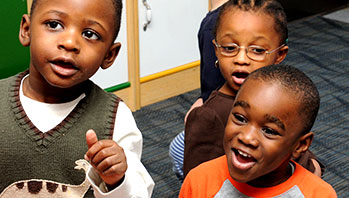- chart paper
- marker
- Roller Coaster (book)
- feeling
MA Standards:
English Language Arts/Speaking and Listening/SL.PK.MA.1a: Observe and use appropriate ways of interacting in a group (e.g., taking turns in talking, listening to peers, waiting to speak until another person is finished talking, asking questions and waiting for an answer, gaining the floor in appropriate ways).
Head Start Outcomes:
Language Development/Receptive Language: Attends to language during conversations, songs, stories, or other learning experiences.
Social Emotional Development/Social Relation: Recognizes and labels others’ emotions.
Social Emotional Development/Self-Concept and Self-Efficacy: Identifies personal characteristics, preferences, thoughts, and feelings.
Social Emotional Development/Self-Regulation: Recognizes and labels emotions.
PreK Learning Guidelines:
English Language Arts/Reading and Literature 12 Listen to, recite, sing, and dramatize a variety of age-appropriate literature.
Health Education 16: Recognize and describe or represent emotions such as happiness, surprise, anger, fear, sadness.
Recite Together: “Feelings”

© Commonwealth of Massachusetts, Department of Early Education and Care (Jennifer Waddell photographer). All rights reserved.
ELA Focus Skills: Speaking and Listening, Vocabulary
Educator Prep:
Copy the words to the poem “Feelings” on chart paper and display it where children can view it.Display the cover of Roller Coaster by Marla Frazee and draw attention to the people’s faces. Ask, Why do you think all the people have the same expression on their faces?
- Talk about how sometimes when you are feeling something, it can show in the expression on your face.
- Demonstrate a frown and ask children to tell how they think you are feeling. (sad)
- Then make an exaggerated smile while humming a tune and ask children to tell you how they think you are feeling. (happy)
- Have a few volunteers demonstrate how they think they would feel if they were on the roller coaster.
Recite the rhyme “Feelings” with children and ask them to make their facial expression match the feeling words as you read them in the rhyme.
Feelings
Feelings come and feelings go,
Sometimes fast and sometimes slow.
Sometimes happy, sometimes sad,
Sometimes silly, sometimes mad.
Feelings come and feelings go,
And on my face my feelings show.
Take It Further: To introduce different feelings, follow the little girl’s (and other people’s) changing expressions throughout the story. Discuss what is happening in each picture (or why she’s feeling that way). On the last page, ask children why they think people have different feelings about riding the roller coaster. (because it’s fast when it goes downhill)
Take It Further: You may want to show the second to last page of the book (people leaving the roller coaster) to discuss the different emotions shown on people’s faces.
English Language Learners: Help children understand different emotions and emotion words. Show a picture of an excited face and say in an excited tone, “I’m so excited!” Have children make an expression and repeat the sentence after you using the same tone of voice as you used. Repeat the activity using a picture of a frightened face.
